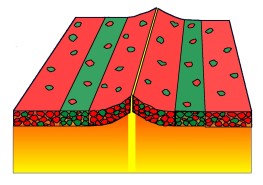By Dr. Don Batten
Further Geological evidence for a young age of the earth
- Existence of significant flat plateaux that are “dated” at many millions of years old (“elevated paleoplains”). An example is Kangaroo Island (Australia). C.R. Twidale, a famous Australian physical geographer wrote: “the survival of these paleoforms is in some degree an embarrassment to all the commonly accepted models of landscape development.” Twidale, C.R. On the survival of paleoforms, American Journal of Science 5(276):77–95, 1976 (quote on p. 81). See Austin, S.A., Did landscapes evolve? Impact 118, April 1983.
- The recent and almost simultaneous origin of all the high mountain ranges around the world—including the Himalayas, the Alps, the Andes, and the Rockies—which have undergone most of the uplift to their present elevations beginning “five million” years ago, whereas mountain building processes have supposedly been around for up to billions of years. See Baumgardner, J., Recent uplift of today’s mountains. Impact 381, March 2005.
- Water gaps. These are gorges cut through mountain ranges where rivers run. They occur worldwide and are part of what evolutionary geologists call “discordant drainage systems”. They are “discordant” because they don’t fit the deep time belief system. The evidence fits them forming rapidly in a much younger age framework where the gorges were cut in the recessive stage / dispersive phase of the global Flood of Noah’s day. See Oard, M., Do rivers erode through mountains? Water gaps are strong evidence for the Genesis Flood, Creation 29(3):18–23, 2007.
- Erosion at Niagara Falls and other such places is consistent with just a few thousand years since the biblical Flood.
- River delta growth rate is consistent with thousands of years since the biblical Flood, not vast periods of time. The argument goes back to Mark Twain. E.g. 1. Mississippi—Creation Research Quarterly (CRSQ) 9:96–114, 1992; CRSQ 14:77; CRSQ 25:121–123. E.g. 2 Tigris–Euphrates: CRSQ 14:87, 1977.
- Underfit streams. River valleys are too large for the streams they contain. Dury speaks of the “continent-wide distribution of underfit streams”. Using channel meander characteristics, Dury concluded that past streams frequently had 20–60 times their current discharge. This means that the river valleys would have been carved very quickly, not slowly over eons of time. See Austin, S.A., Did landscapes evolve? Impact 118, 1983.
- Amount of salt in the sea. Even ignoring the effect of the biblical Flood and assuming zero starting salinity and all rates of input and removal so as to maximize the time taken to accumulate all the salt, the maximum age of the oceans, 62 million years, is less than 1/50 of the age evolutionists claim for the oceans. This suggests that the age of the earth is radically less also.
- The amount of sediment on the sea floors at current rates of land erosion would accumulate in just 12 million years; a blink of the eye compared to the supposed age of much of the ocean floor of up to 3 billion years. Furthermore, long-age geologists reckon that higher erosion rates applied in the past, which shortens the time frame. From a biblical point of view, at the end of Noah’s Flood lots of sediment would have been added to the sea with the water coming off the unconsolidated land, making the amount of sediment perfectly consistent with a history of thousands of years.
- Iron-manganese nodules (IMN) on the sea floors. The measured rates of growth of these nodules indicates an age of only thousands of years. Lalomov, A.V., 2007. Mineral deposits as an example of geological rates. CRSQ 44(1):64–66.
- The age of placer deposits (concentrations of heavy metals such as tin in modern sediments and consolidated sedimentary rocks). The measured rates of deposition indicate an age of thousands of years, not the assumed millions. See Lalomov, A.V., and Tabolitch, S.E., 2000. Age determination of coastal submarine placer, Val’cumey, northern Siberia. Journal of Creation (TJ) 14(3):83–90.
- Pressure in oil / gas wells indicate the recent origin of the oil and gas. If they were many millions of years old we would expect the pressures to equilibrate, even in low permeability rocks. “Experts in petroleum prospecting note the impossibility of creating an effective model given long and slow oil generation over millions of years (Petukhov, 2004). In their opinion, if models demand the standard multimillion-years geochronological scale, the best exploration strategy is to drill wells on a random grid.” Lalomov, A.V., 2007. Mineral deposits as an example of geological rates. CRSQ 44(1):64–66.
- Direct evidence that oil is forming today in the Guaymas Basin and in Bass Strait is consistent with a young earth (although not necessary for a young earth).
- Rapid reversals in paleomagnetism undermine use of paleomagnetism in long ages dating of rocks and speak of rapid processes, compressing the long-age time scale enormously.
- The pattern of magnetization in the magnetic stripes where magma is welling up at the mid-ocean trenches argues against the belief that reversals take many thousands of years and rather indicates rapid sea-floor spreading as well as rapid magnetic reversals, consistent with a young earth (Humphreys, D.R., Has the Earth’s magnetic field ever flipped? Creation Research Quarterly 25(3):130–137, 1988).
- Measured rates of stalactite and stalagmite growth in limestone caves are consistent with a young age of several thousand years. See also articles on limestone cave formation.
- The decay of the earth’s magnetic field. Exponential decay is evident from measurements and is consistent with theory of free decay since creation, suggesting an age of the earth of less than 20,000 years.
- Excess heat flow from the earth is consistent with a young age rather than billions of years, even taking into account heat from radioactive decay. SeeWoodmorappe, J., 1999. Lord Kelvin revisited on the young age of the earth. Journal of Creation (TJ) 13(1):14, 1999.

Measured erosion rates at places like Niagara Falls are consistent with a time frame of several thousand years since Noah’s Flood.

Along the mid-ocean ridges, the detailed pattern of magnetic polarisation, with islands of differing polarity, speaks of rapid changes in direction of Earth’s magnetic field because of the rate of cooling of the lava. This is consistent with a young Earth.
Source: Creation.com
Thank you! I also recommend Dr. Jason Lisle's book: The Ultimate Proof of Creation. You can find it at Answers in Genesis! God bless you!
ReplyDelete